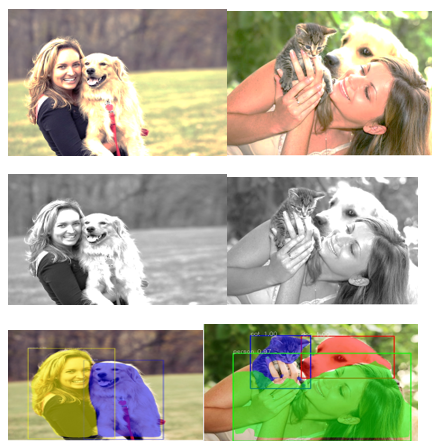An Efficient Data Analytics and Optimized Algorithm for Enhancing the Performance of Image Segmentation Using Deep Learning Model
Main Article Content
Abstract
Image segmentation is the key topic in computer vision and image processing with applications like robotic perception, scene understanding, video surveillance, image compression, medical image analysis, and augmented reality among many others. There are numerous algorithms are developed in the literature for image segmentation. This paper provides a broad spectrum of pioneering works for instance and semantic level segmentation with mask Region based Convolution Neural Network with Monarch butterfly Optimization (RCNN-MBO) architecture. The system is initially constructed in a Python environment with images of people and animals being input. Remove the unnecessary data from the gathered datasets during the pre-processing stage. Next, use a stochastic threshold function to segment the image. Then update the segmented images into a designed model for detecting and classifying a group of images. The main goal of the designed approach is to attain accurate prediction results also improve the performance of the designed model by attaining better results. To enhance the performance, two activation functions were used and MBO fitness is updated in the classification layer. It improves the prediction results and takes less time to detect and classify images. Finally, the experimental outcomes show the reliability of the designed approach by other conventional techniques in terms of accuracy, precision, sensitivity, specificity, F-measure, error rate, and computation time.
Article Details
References
Hertel, Anne G., et al. "A guide for studying among-individual behavioral variation from movement data in the wild." Movement Ecology 8.1 (2020): 1-18.
Karp, Denise. "Detecting small and cryptic animals by combining thermography and a wildlife detection dog." Scientific reports 10.1 (2020): 1-11.
Gemeda, D. O., and S. K. Meles. "Impacts of human-wildlife conflict in developing countries." Journal of Applied Sciences and Environmental Management 22.8 (2018): 1233-1238.
Gräfe, Sophia. "Red Foxes in the Filing Cabinet: Günter Tembrock's Image Collection and Media Use in Mid?Century Ethology." Berichte zur Wissenschaftsgeschichte (2022).
Mo, Yujian, et al. "Review the state-of-the-art technologies of semantic segmentation based on deep learning." Neurocomputing 493 (2022): 626-646.
Schofield, Daniel, et al. "Chimpanzee face recognition from videos in the wild using deep learning." Science advances 5.9 (2019): eaaw0736.
Islam, Sazida B., and Damian Valles. "Identification of wild species in texas from camera-trap images using deep neural network for conservation monitoring." 2020 10th Annual Computing and Communication Workshop and Conference (CCWC). IEEE, 2020.
Nazir, Sajid, and Muhammad Kaleem. "Advances in image acquisition and processing technologies transforming animal ecological studies." Ecological Informatics 61 (2021): 101212.
Arunachalam, Harish Babu, et al. "Viable and necrotic tumor assessment from whole slide images of osteosarcoma using machine-learning and deep-learning models." PloS one 14.4 (2019): e0210706.
Corcoran, Evangeline, et al. "Automated detection of wildlife using drones: Synthesis, opportunities and constraints." Methods in Ecology and Evolution 12.6 (2021): 1103-1114.
Steinberg, Idan, et al. "Photoacoustic clinical imaging." Photoacoustics 14 (2019): 77-98.
Sengan, Sudhakar, et al. "Real-Time Automatic Investigation of Indian Roadway Animals by 3D Reconstruction Detection Using Deep Learning for R-3D-YOLOV3 Image Classification and Filtering." Electronics 10.24 (2021): 3079.
El Abbadi, Nidhal K., and Elham Mohammed Thabit A. Alsaadi. "An automated vertebrate animals classification using deep convolution neural networks." 2020 International Conference on Computer Science and Software Engineering (CSASE). IEEE, 2020.
Kellenberger, Benjamin, Diego Marcos, and Devis Tuia. "Detecting mammals in UAV images: Best practices to address a substantially imbalanced dataset with deep learning." Remote sensing of environment 216 (2018): 139-153.
Possidónio, Catarina, et al. "Animal images database: Validation of 120 images for human-animal studies." Animals 9.8 (2019): 475.
van der Wal, Jessica EM, et al. "Safeguarding human–wildlife cooperation." Conservation Letters (2022): e12886.
Lahoz-Monfort, José J., and Michael JL Magrath. "A comprehensive overview of technologies for species and habitat monitoring and conservation." BioScience 71.10 (2021): 1038-1062.
Li, Daoliang, and Ling Du. "Recent advances of deep learning algorithms for aquacultural machine vision systems with emphasis on fish." Artificial Intelligence Review 55.5 (2022): 4077-4116.
Latif, Jahanzaib, et al. "Digital Forensics Use Case for Glaucoma Detection Using Transfer Learning Based on Deep Convolutional Neural Networks." Security and Communication Networks 2021 (2021).
Wäldchen, Jana, and Patrick Mäder. "Machine learning for image based species identification." Methods in Ecology and Evolution 9.11 (2018): 2216-2225.
Vatsavayi, V.K. and Andavarapu, N., 2022. Identification and classification of wild animals from image sequences using hybrid deep residual convolutional neural network. Multimedia Tools and Applications, pp.1-26.
Chandrakar, R., Raja, R. and Miri, R., 2021. Animal detection based on deep convolutional neural networks with genetic segmentation. Multimedia Tools and Applications, pp.1-14.
Chithra, P.L. and Sathya, K., 2022. CAPTCHAs against meddler image identification based on a convolutional neural network. Multimedia Tools and Applications, 81(6), pp.8633-8652.
Ricolfe-Viala, C. and Blanes, C., 2022. Improving Robot Perception Skills Using a Fast Image-Labelling Method with Minimal Human Intervention. Applied Sciences, 12(3), p.1557.
Hussain, A., Ali, S. and Kim, H.C., 2022. Activity Detection for the Wellbeing of Dogs Using Wearable Sensors Based on Deep Learning. IEEE Access, 10, pp.53153-53163.
Wang, Gai-Ge, Suash Deb, and Zhihua Cui. "Monarch butterfly optimization." Neural computing and applications 31.7 (2019): 1995-2014.
Cuevas, Erik, Daniel Zaldivar, and Marco Pérez-Cisneros. "A novel multi-threshold segmentation approach based on differential evolution optimization." Expert Systems with Applications 37.7 (2010): 5265-5271.

